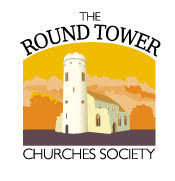The blaze at St Mary’s in Beachamwell has cast a spotlight on one of Norfolk’s greatest historical assets. MICHAEL POLLITT explains the cultural importance of the county’s unrivalled collection of round tower churches
A devastating fire virtually destroyed a Norfolk round towered church, St Mary’s, Beachamwell, in just one morning this week (Wednesday, February 2, 2022).
Amid the ruins of this 14th century medieval church, its round tower, including Saxon and post-Norman Conquest features, still stands and demonstrates the vulnerability of our precious church heritage.
Norfolk has the world’s largest concentration of medieval churches but it is also home to two-thirds of the country’s 186 round tower churches.
There are 131 standing towers or visible remains in Norfolk while Suffolk has 41, Essex seven and two in Cambridgeshire, which were built from Saxon times through to about 1400.
Almost all have been built with flint and traditional lime mortar although some in the west of Norfolk have dark-brown carstone, puddingstone or conglomerate.
The earliest were bell towers – a Papal edict in 937AD encouraged their construction – and later Saxon thegns or landowners were required by Kings of England to build churches on their manors.
As Norfolk has no natural stone, builders used locally available material – flint and lime mortar.
As the Romans recognised, when built slowly, circular structures were strong when built in stages, as mortar slowly hardened.
Interesting, this theory was tested when a new round tower using flint and lime mortar was built as a demonstration project at Swaffham in 2001.
It is probable the early towers were built in stages in the drier summer months in about nine inch layers; these hardened before more layers were added.
The following season, having collected more flints during the winter, they returned and would typically add possibly another 6ft to 8ft, again in stages.
The county’s round tower heritage was recognised by the Royal Mail almost half a century ago.
Five stamps, issued on June 21, 1972, marked British architecture and village churches, including the then 5p first class illustration of St Andrew’s, Letheringsett, near Holt.
Shortly before the Covid lockdown, a south Norfolk grade I listed church, St Margaret, Hales, near Loddon, was featured in the opening film scenes of Armando Iannucci’s The Personal History of David Copperfield in early 2020.
It may seem surprising, given the large number of these churches in the county, that it was not until 1973 that a retired television engineer Bill Goode, founded the Round Tower Churches Society.
In the past 49 years, its membership has grown to almost 500 and remarkably, the charity has now given grants close to £300,000 to maintain and preserve these special churches.
The first grant, £20, was given in August 1974 to help meet the cost of re-thatching St Mary the Virgin, Cranwich, near Thetford.
In the past two years, it has given almost £36,000 to a dozen churches.
A wealthier sister charity, the Norfolk Churches Trust, has been equally generous too.
In fact, both charities had each given Beachamwell £3,000 towards re-thatching costs.
Some round tower churches have been lost – the Baedeker Raids on Norwich in spring 1942 accounted for three of the city’s churches.
St Paul’s, near what is now the Puppet Theatre, was destroyed on June 27; the tower of St Benedict’s was left standing and St Julian was destroyed, re-built and re-opened in 1953.
More recently on Thursday, August 29, 1991, the south side of the tower at All Saints, Cockley Cley, near Swaffham, fell.
The belfry above the nave roof ridge collapsed but left the rest of the church.
In south Norfolk on February 9, 2020, about four tonnes of flint and material fell from the ruined tower of the 12th century St Mary’s church, Kirby Bedon.
It happened during Sunday service at nearby St Andrew’s just 50 yards away – caused probably by prolonged wet weather, high winds and Storm Ciara.
There is a huge challenge for church conservation charities to raise funds.
While the recent three-year VAT concession (to March 31, 2025) for conservation repairs is welcome – the Listed Places of Worship grant scheme, there is concern that the scale of the challenge is not fully appreciated by heritage grant-making bodies.
On a more local level, thefts of church lead – fortunately reduced by installing roof alarms – and vandalism remain ever-present threats.
Thieves struck at the round tower church of St Mary, Long Stratton. Again, the Society helped, donating £2,000.
Quite why welcoming the new year encourages smashing windows at the grade I listed St Margaret, Hales, and stealing a wooden communion rail, is a mystery.
And, almost weekly, there are incidents of damage to remote churches.
As membership organisations maintaining the county’s church heritage, individual support can really make a difference.
It costs a minimum £20 pa to join the Round Tower Churches Society.
Michael Pollitt is vice-chairman of the Round Tower Churches Society and the EDP’s former agricultural editor
See website www.roundtowers.org.uk for further details and £30pa for the Norfolk Churches Trust – www.norfolkchurchestrust.org.uk or the Churches Conservation Trust – supporters@thecct.org.uk
